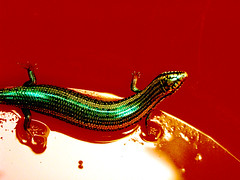
Buying your first lizard should be done with caution. Lizards make great pets, but there’s more to taking care of one than you might imagine. There are lizards that need a great deal of care and a more expensive set up in food and living quarters than other lizards, so choose with care. Know what your options are, so you and your new lizard will both be happy and content.
Most lizards, except the very exotic kind, are not that expensive to purchase. The type of lizard that you buy determines other costs. For example, the Black and White Tegu lizard requires a large area for its house, so it costs more to build or buy the housing for it. When you want to buy your first lizard you’ll need to look at lighting effects for your lizard too. If you’ve got a lot of room, then you’ll be able to accommodate an iguana that will grow up to six feet, but please remember that before you buy, even if you’ve got the room. It takes time, commitment and money to keep a lizard happy and healthy.
A Leopard gecko is a lizard that’s very good to buy if you’re a first time buyer. Leopards don’t require any expensive blue light for their enclosure, only a warming light. Reptiles are cold blooded so they all need a little warmth, especially in the cold winter months. Most owners of lizards will hang a light bulb above the enclosure to keep it warm. Don’t place it in their cage, or it will end up burning their reptilian skin. A standard 100-watt light bulb works nice for the animal. This lizard needs at least 50% humidity too, so keep a check on how humid you keep their cage. If you don’t they will loose body moisture and die.
Lizards that are active at night don’t like too much light, but they need ultra violet light so they can convert it into the necessary vitamins to make strong bones. Without the vitamin they’ll get scurvy and the joints will swell, eventually the lizards will die because they become paralyzed. Also, when you buy a lizard make sure that its feeding requirements are understood clearly. Feeding each type of reptile, either the Leopard or the bearded dragon, for a beginner can seem a bit confusing. For example, the Leopard only eats insects as their main diet, and the Bearded eats both plants and bugs, for theirs. Each lizard requires supplement foods to be added to their diets. You’ll need to feed a mixture of foods to both, like berries bananas, mice, and crickets that are loaded with nutrients. The bugs that you give them will need to be fed with the same supplements before feeding them to the lizards.
Drinking is another issue with a beginner reptile owner. Lizard can’t drink from a water bottle, so you’ll need to provide clean water everyday in a bowl that’s preferably ceramic. They won’t tip it over as easily, and the ceramic is not dangerous to their digestive system if it flakes a little. Young bearded dragons are known to be stubborn on drinking or just playful, and will knock their bowl over, but you can solve that problem. Lightly mist the inside of the cage area, and they’ll get all of the water they need. Also, don’t be surprised if your lizard goes through stages of not wanting to eat or drink as much in the winter months. It is just a part of the way they digest, but never force-feed them. This can cause stomach problems.
There are a lot of different lizards that you can choose from as a new lizard owner. Some others are the Green Anole, Madagascar, and the thick tailed gecko. A good way to decide what type you want is talk with a local veterinarian that works with exotic pets of the reptilian variety. They can advise you and work with you on getting your first lizard, and caring for it after you’ve brought it home. Remember, lizards are a lot of fun, but they’re more challenging to care for because they belong to the reptile family. Each lizard is as different as the next lizard, and by knowing how to care for him or her, you’ll have a fascinating time learning more about him or her.